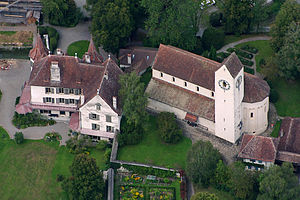Amsoldingen Castle
| Amsoldingen Castle | |
|---|---|
| Schloss Amsoldingen | |
| Amsoldingen | |

Amsoldingen Castle
|
|
| Coordinates | 46°43′38″N 7°34′44″E / 46.727182°N 7.578859°E |
| Type | Castle |
| Site information | |
| Owner | Canton of Bern |
| Open to the public |
no |
| Site history | |
| Built | 10th century |
| Materials | stone |
Amsoldingen Castle (German: Schloss Amsoldingen) is a castle in the municipality of Amsoldingen in the canton of Bern in Switzerland. It is a Swiss heritage site of national significance.
Amsoldingen Castle and the neighboring collegiate church of St. Mauritius were built in the 10th century. The church was built from stone scavenged from the ruins of Aventicum on the foundations of an earlier church built around 700. The castle was built as the residence of the wealthy provost of the Stift of the collegiate church of Amsoldingen. According to tradition, the Stift or donation was made in the 10th century by the King of Burgundy Rudolph II. It was one of the twelve churches that he founded around Lake Thun. Over the following centuries, the Stift gradually became impoverished and in 1484 the Pope approved the dissolution of the Stift and its incorporation into the newly created Stift of St. Vincent's cathedral in Bern. The college of canons in Bern sold the castle and surrounding lands in 1496 to the wealthy merchant Barthlome May. In 1536, Barthlome's grandson, Sulpitius May, sold the castle, after which it passed through a number of owners.
By the end of the 17th century it was owned by the engineer and surveyor Samuel Bodmer. Between 1711 and 1724, Bodmer lived in the castle as he designed the flood control system around Thun Lake and the Aare River to protect the villages and farm land from floods. During the 18th and early 19th century the castle was owned by the Luternau family who built the parks around the castle. It was sold in 1815 to Ludwig Zeerleder, who then sold it to Alfred de Rougemont von Bonstetten, who later sold it to Beat Ludwig Tscharner von Erlach. Under von Erlach the castle was rebuilt in a neo-Gothic style in 1846.
...
Wikipedia


